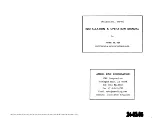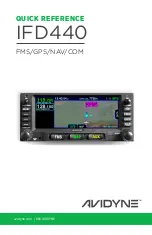
Mid-Continent Instruments, Wichita, KS
Rev B May 25, 2004 Manual Number 9015762 Page 18 of 21
Section 3: Operation
3.1 General
This section describes the Model 4300-4XX Electric Attitude Indicator operating procedures. The
indicator is required to be installed in an aircraft with the specified inputs applied. Figure 1.2
provides an illustration of a typical Model 4300 display and a table describing indicator functions.
3.2 Starting
Procedures
The following operational procedures are recommended when preparing the indicator for use:
CAUTION: THE INDICATOR MAY BE DAMAGED IF THE “PULL TO CAGE” KNOB IS
RELEASED WITH A “SNAP.” SLOWLY RELEASE “PULL TO CAGE” KNOB
AVOIDING A “SNAP” RELEASE.
NOTE:
Indicator may be momentarily caged by pulling “PULL TO CAGE” knob to the fully
extended position, holding knob until the display stabilizes, and then allowing the
knob to return to the normal position.
A. Apply power to the indicator. Note that the Gyro Warning flag (red) will pull out-of-
view. Allow three minutes for presentation stabilization.
B. On models with trim adjustment, rotate the symbolic airplane adjustment knob for
the desired pitch attitude presentation, i.e. aligning the symbolic airplane with the
horizon.
C. If caging is required, caging should be accomplished when the aircraft is in a wings
level, normal cruise attitude, as indicated by other instruments or the earth’s horizon.
If the gyro is caged when the aircraft is not in this attitude, the resulting attitude
presentation immediately after caging will be in error by the difference between true
vertical and actual aircraft attitude. Small errors in caging erection will be corrected
by the indicator to true vertical in pitch and roll at 2.5
°
per minute minimum (5
°
/min.
nominal).
3.3 In-Flight
Procedures
A. Adjust the symbolic airplane to obtain desired pitch attitude presentation after take-
off.
B. In the event of errors in excess of 10
°
caused by extended bank or fore-aft
acceleration, the indicator should be momentarily caged after the aircraft is returned
to level flight.
3.4 Dynamic
Errors
A. Turn Induced Errors
Pitch indication errors resulting from a standard coordinated turn (180 degrees in
one minute at a true airspeed of 156 knots) will not exceed 3
°
. Dynamic errors
developed under non-standard conditions may be greater. Errors that develop will be
self corrected by the internal erection system or manually corrected by the actuation
of the caging system.
























